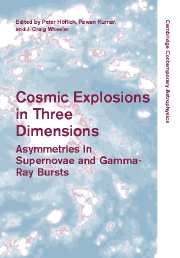Book contents
- Frontmatter
- Contents
- Part I Introduction
- Part II Supernovae: Observations Today
- Part III Theory of Thermonuclear Supernovae
- 10 Semi-Steady burning evolutionary sequences for CAL 83 and CAL 87: Super Soft X-ray binaries are supernova Ia progenitors
- 11 Type Ia progenitors: effects of spin-up of white dwarfs
- 12 Terrestrial combustion: feedback to the stars
- 13 Non-spherical delayed detonations
- 14 Numerical simulations of Type Ia supernovae: deflagrations and detonations
- 15 Type Ia supernovae: spectroscopic surprises
- 16 Aspherity effects in supernovae
- 17 Broad lightcurve SNe Ia: asymmetry or something else?
- 18 Synthetic spectrum methods for three-dimensional supernova models
- 19 A hole in Ia? Spectroscopic and polarimetric signatures of SN Ia asymmetry due to a companion star
- 20 Hunting for the signatures of 3-D explosions with 1-D synthetic spectra
- 21 On variations in the peak luminosities of Type Ia supernovae
- Part IV Theory of Core Collapse Supernovae
- Part V Magnetars, N-Stars, Pulsars
- Part VI Gamma-ray Bursts
- Part VII Conference Summary
- References
14 - Numerical simulations of Type Ia supernovae: deflagrations and detonations
Published online by Cambridge University Press: 11 August 2009
- Frontmatter
- Contents
- Part I Introduction
- Part II Supernovae: Observations Today
- Part III Theory of Thermonuclear Supernovae
- 10 Semi-Steady burning evolutionary sequences for CAL 83 and CAL 87: Super Soft X-ray binaries are supernova Ia progenitors
- 11 Type Ia progenitors: effects of spin-up of white dwarfs
- 12 Terrestrial combustion: feedback to the stars
- 13 Non-spherical delayed detonations
- 14 Numerical simulations of Type Ia supernovae: deflagrations and detonations
- 15 Type Ia supernovae: spectroscopic surprises
- 16 Aspherity effects in supernovae
- 17 Broad lightcurve SNe Ia: asymmetry or something else?
- 18 Synthetic spectrum methods for three-dimensional supernova models
- 19 A hole in Ia? Spectroscopic and polarimetric signatures of SN Ia asymmetry due to a companion star
- 20 Hunting for the signatures of 3-D explosions with 1-D synthetic spectra
- 21 On variations in the peak luminosities of Type Ia supernovae
- Part IV Theory of Core Collapse Supernovae
- Part V Magnetars, N-Stars, Pulsars
- Part VI Gamma-ray Bursts
- Part VII Conference Summary
- References
Summary
Abstract
We study a thermonuclear explosion of a carbon-oxygen white dwarf (WD) using a three-dimensional hydrodynamic model with a simplified mechanism for nuclear reactions and energy release. The explosion begins as a deflagration with the flame front highly distorted by the Rayleigh-Taylor instability. Turbulent combustion and convective flows produce an inhomogeneous mixture of burned and unburned materials that extends from the center to about 0.8 of the radius of the expanding WD. At this stage, a detonation is ignited and propagates through the layers of unburned material with the velocity about 12,000 km/s, which is comparable to the expansion velocities induced in outer layers of the WD by the subsonic burning. During the period of detonation propagation, the density of the expanding unreacted material ahead of the shock can decrease by an order of magnitude compared to its value before the detonation started. Because the detonation burns material to different products at different densities, it can create a large-scale asymmetry in composition if it starts far from the WD center. In contrast to the 3-D deflagration model, the 3-D delayed-detonation model of SN Ia explosions does not leave carbon, oxygen, and intermediate-mass elements in central parts of a WD. This removes the key disagreement between simulations and observations, and confirms that the delayed detonation is currently the most promising mechanism for SN Ia explosions.
Introduction
Type Ia supernovae (SNe Ia) [1–10] result from the most powerful thermonuclear explosions in the Universe.
- Type
- Chapter
- Information
- Cosmic Explosions in Three DimensionsAsymmetries in Supernovae and Gamma-Ray Bursts, pp. 121 - 131Publisher: Cambridge University PressPrint publication year: 2004
References
- 1
- Cited by



